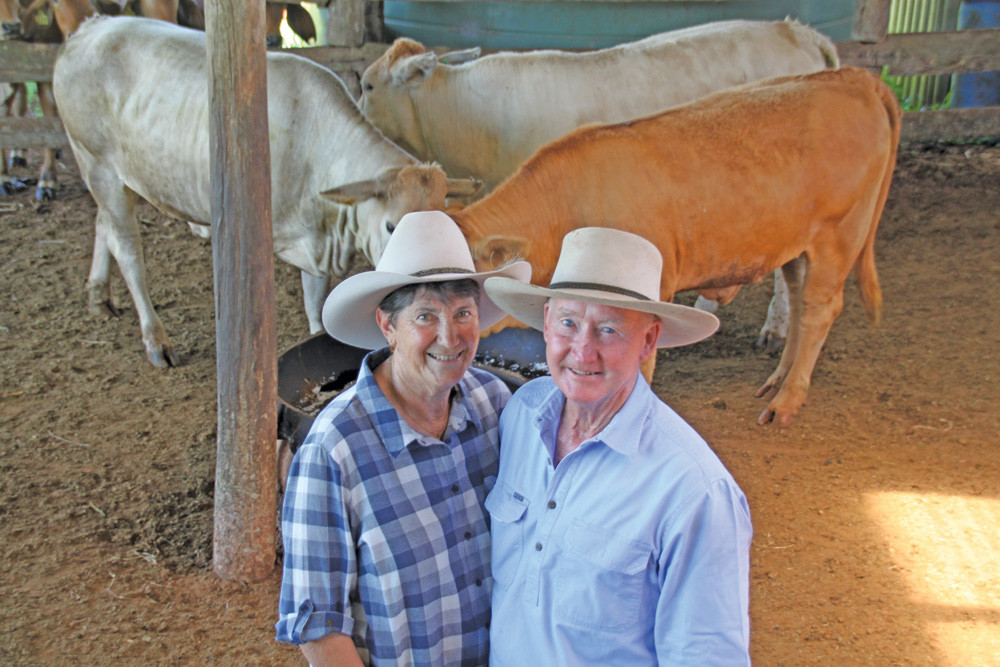On The Land
12 November, 2022
Graziers seek feedback from Beef Awards
After 42 years of farming, Upper Barron graziers, Greg and Di Binnie are participating in their first ever carcase competition. They will be entering a pen of three home-bred and home-grown Charbray heifers into this month's Rocky Creek Abattoir's Best Beef Awards.

We have been breeding and fattening cattle for a long time and have had quite a few successful entries in the prime section of the Malanda show over the years,” Mr Binnie said.
“We have used every available method to assess our cattle's performance. We use EBV figures when buying our bulls and believe the carcase competition is a good way to see if we are on the right track.
“We take all our steers through to Jap Ox, channeling them into two separate markets - the smaller fellas go to Rocky Creek abattoirs and the fat cows and all the bullocks that will dress over 320kg go to JBS in Townsville.
“We don't get much feedback on the eating quality of our cattle once they are sold and we are extra keen to participate in the Best Beef Awards because it is a Grass-fed competition. It will be good to toss our cattle up against the specs and see how they shape up.
“We run a separate herd of select cows that we mate with good Brahman bulls from the Charters Towers Big Country Bull Sale to breed replacement heifer for the operation. The rest go to Charolais bulls for that extra weight from the cross, to be bred as a terminal herd of bullocks and spayed heifers.
“The heifers are by Palgrove Charolais bulls out of high-grade Brahman cows and we have se-lected three that have good eye muscle area and even fat coverage. Our cattle are all pasture fed and we just feed the calves a bit of hay and molas-ses during weaning.
“Most calves are weaned at eight months of age, all the weaners are blooded twice and the males are vaccinated against three day. We try and keep them clear of worms and ticks until they are
18 months old. We handle them as much as we can to educate them at a young age.
“We put a lot of pressure on our heifers to calve or be well in calf by two years of age, they must mother well and have good udders. We find when the cow is in better condition, the calves grow more pre-birth, making it easier for us to trade in milk and two tooth cattle by 24-30 months of age.
“At 10 months, the weaners are sent out to fat-ten on a mixture of Guinea and Hamil grass, Brachiaria, Setaria, Tinaroo glycine and Shaw creeping Vigna at a conservative stocking ratio of one steer or heifer to .6ha They usually do around .7kg and up to .8kg weight gain per day.”
Long recognised by their industry as good op-erators, it has taken Greg and Di decades of hard work and dedication to put together their 385ha aggregation of highly productive Upper Barron and Malanda country and their quality herd of Brahman and Charbray cattle.
“After seven years of looking, we bought our first 113ha farm in 1980. I was earning $117 a week ($6,084/yr) working as a butcher for Darcy Byrnes and we paid $85,000 for the block. The place was very run down and needed a lot of work repairing fences and building yards,” Mr Binnie said.
“We had to clear the last of the country and plant all the improved pastures and couldn't af-ford to buy a tractor initially, so we had to use our horses for everything.”
Mrs Binnie recalled how they used to put a roll of plain wire around their horse's necks and attach a container of herbicide to the pummel of the sad-dle and head out fencing and poisoning weeds, but said they were just tickled pink to have their own farm.
“We had around 300 breeders agisted out at Gunnawarra, Wyoming and Yammanie Stations for nearly 20 years. We enjoyed it out bush. We would take lick out to the cattle every fortnight and just sit at the dam, watching them with their calves,” she said.
“We kept tabs on everything and can follow our calves' bloodlines back four generations.
"We operate a two-strike system with our heifers, mating them to two different bulls in two years. If they don't go in calf consistently or produce good-conditioned calves, they will be on the truck.”
Both from Tableland farming families, Greg grew up on his family's Malanda dairy farm and Di, a Pensini by birth, grew up farming corn and hay.
“We loved what we are doing so much, we thought because we had two children, we should try and buy another farm in case they wanted to come back to the land,” she said.
“When we brought the cattle home from the
dry country, we came back and bought another couple of blocks here. Once you get on this wheel, you can't really get off, so over the years, we have just picked everyone's brain and taken on the bits that appealed to us and kept trying to improve our operation.”
Greg and Di are quietly confident they will do well in the competition.
“We always eat our own beef, we reckon our grass-fed beef is sweeter and has more flavour than grain-fed. Why would we go out and buy steak when we have the best at home,” Di laughed.


